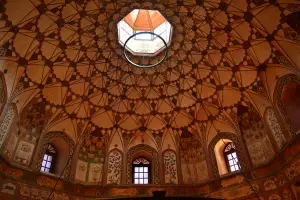By Tania Qureshi
Did you know that the only exiting Turkish style Mughal Era Royal Bath is right here in old Lahore? Yes, that’s the exquisite Royal bath known as Shahi Hammam in the local language.
As you enter the gigantic arches of the colonial-built Delhi Gate, inside the walled city of Lahore, on your left is this 17th century wonder ‘Shahi Hammam’, now restored and conserved by the Walled City of Lahore Authority (WCLA) and the Aga Khan Trust for Culture (AKTC) with the funding from government of Punjab and the Royal Norwegian Embassy.
Before I take you into this wonderland monument, let me tell you that it also received the UNESCO Award of Merit in 2016 for its best conservation in this region. Let me start from 2007 when I got to know about this monument hidden behind several encroachments and had almost lost its glory and majesty. to my surprise, the locals as well did not know anything about this monument. The office of TDCP (Tourism Development Corporation Punjab) was set up in this building which was breathings its last.
Outside the building were the encroachments and inside the building laid the marble floorings, white wash on walls and ceilings, boards and LCDs placed on the walls and offices in the historic heritage rooms. Well, no one could think that one day it would transform into a masterpiece! I began visiting the monument again and again as somehow it attracted me towards itself, trust me it pulls you towards itself and there is some mystery hidden in the walls and aura of the monument.

Then came the year 2012 and the encroachments were removed from its façade and western side by the Government of Punjab and a project ‘Sustainable Development of Walled City Lahore Project’ which later turned into the Walled City of Lahore Authority. Almost 57 encroachments were removed and the façade of the monument was revealed.
After sometime, in 2014, the WCLA and AKTC planned the conservation of the monument and Shahi Hammam was officially transferred to WCLA for conservation and re-use. The conservation began and the entire shape of the monument was changed – rather the real hammam was revealed.
During the conservation of the Shahi Hammam, the walls which were painted with white wash had to be cleaned with certain chemicals for revealing the fresco underneath. For this task fresco experts were called from Sri Lanka who toiled with the students of National College of Arts. This was a good initiative as training our own resource in fresco. Marble floors were laid in all the rooms of the Hammam in 1991 restoration by the Archeology department. These floors were excavated to re-establish the hypocaust system (system through which the steam was produced and water was heated). Underneath the marble floor was a whole new world to be explored. The astounding hypocaust system of the Royal Bath is what we know today as the spa or the sauna bath. The conservation was completed in two years.
Reading up till now you must be thinking that what was the Shahi Hammam for? Let me tell you that it was a public bath which was built in 1634 by the Mughal courtier Wazir Khan or Hakim Ilm Ud Din Ansari. Hakim Ilm Ud Din Ansari was known for curing diseases and got close to Muhgal Emperor Jahangir after the treatment of an incurable disease his wife, Noor Jehan, had. The public bath was then named after Wazir Khan and on the same path; the beautiful Mosque of Wazir Khan was also built in the subsequent years.
This public bath or Shahi Hammam, offered extravagant facilities like bathing, massage, spa, sauna and what not, a modern bath house like today’s most expensive salons and parlors. The Hammam was very perfectly managed and must be a fashionable service for travelers and public at that time. It is said by the historians that there were attendants who would welcome the public inside the Hammam and informed them about the services being offered. The Hammami or the attendant provided the people with towel and soap and they would sit in the waiting area of the Hammam for their turn. The hammami or the attendant would call the person on his turn and offer the services of cold and hot bath along with massage. Hair cutting, trimming, manicure and pedicures were also a provision.
The charges of all the services were minimal so that it could serve the masses and all economic classes. If we look at the built of the Hammam and its locale, we see that historically and geographically the existence of Hammam made sense at this place. The travelers would enter the city of Lahore through Delhi Gate, freshen up in Hammam and then went further for offering prayers at the Wazir Khan Mosque ahead. It is claimed by the historians that there was a rest house (Wazir Khan Sarai) opposite this Hammam and provided facility to the travelers for overnight stays. It is said that the rest house was destroyed during the Sikh period and later when a disruptive flood had struck Lahore.
Some historians’ claim, about its use, that it was meant for the royal females only initially and later it was converted into a public bath, and few days of the week were specified for the females. The services for females were offered by female attendants in the Hammam. If you visit the Hammam you will see that the building of the Hammam is still skillfully decorated with fresco work. The cold bath area or the main hall is a stunning success of fresco with all the walls and ceilings ornamented with colorful motifs and designs. This shows the interest of the emperor in building the monuments and paying attention to the details in it. You will see fresco paintings of angles, fruits, flowers and much more which depicts the richness of that time. There are also small opening and windows in the ceilings of each room were made for ventilation and lighting purposes.
You would be surprised to know that supernatural activities have also been observed in the Hammam by the staff. There is a tree which is said to be haunted and every Thursday the community residents come to hammam and light up candles and oil lamps under the tree. Many of the staff members have observed paranormal activities in the hammam. Huge footprints were also once seen in the Hammam and that terrified the staff.
Now let me tell you an interesting fact about the functioning of the Hammam and that how the water was heated and circulated in the Hammam’s cold and hot bath areas and also the steam rooms. During the excavation it was revealed that the steam channels were made under the floor which we now know as hypocaust system. The woods were burnt under huge furnaces having water. That steam would rotate through those channels heating up the floor and the water in the reservoirs. The water pipes in the form of tunnels were concealed masked camouflaged between the walls which provided fresh water to the people. The used water was drained out through the open drain channels in the floor which was collected in a central pipeline from where it was thrown into the main drain of the area.
The Shahi Hammam is a single storey building and covers an area of about 1,000 sq. meters. At present it has 21 inter-connected rooms. These were the bathing rooms. An interesting feature of the rooms is the echo system. standing in one corner you can hear the whispers of the person standing in the other corner of the room. this feature is found in almost all Mughal built buildings and was kept there to keep a surveillance of the gossips and conspiracies.
The waiting area of the Shahi Hammam has now been converted into a conference room with audio visual facilities for the tourists. The main entrance of the Hammam is also changed and the original entrance on the western side has been restored and opened for the tourists.
It is claimed by the historians that the Hammam was an extended building which was partially demolished while reconstructing the Delhi Gate during British Rule. The foundations of some parts of the Hammam were revealed during the present excavation which endorsed the historians. The foundations of other rooms and buildings were also revealed along with the main water channel of the city which has also been preserved for the tourist.
The Shahi Hammam like many other historic buildings underwent different usages during the Sikh and British era. According to some historians and books it is said that the heating system of the Shahi Hammam was destroyed during the Sikh rule and many ornaments were pulled out of the ceilings and walls.
During the British era it was transformed into an accommodation for the police and soldiers. After 1947 it was changed into a boys’ primary school, a girls’ vocational school, a dispensary and also served as office for various government departments. Rooms to provide residences for the government employees were also erected on the roof top. The northwestern rooms (Hujras) were rented out as shops by the Government and additional shops or encroachments were made on the northern, western and southern façades of the Hammam. These encroachments resulted in damaging the structure as well as water ingress in the foundations. In short, every effort was made to destroy the elegance of Shahi Hammam but somehow it survived. This also depicts the solid structure and stability of the building material that was used in its construction during those days. Now we do not have such solid structures or maybe the material is changes now. This is why that the building passed every test of turbulence successfully.
After conservation and revealing of the original royal bath, the WCLA launched guided tours of the hammam. A souvenir shop was established there along with a small café for the tourists. Interesting fact is that the Shahi Hammam roof top and courtyards are also used for community and social gatherings. This wonder is a must visit site. There are tourist guides for tourists in the Shahi Hammam who very welcomingly take you around the monument and show you the hidden gems and rooms.







